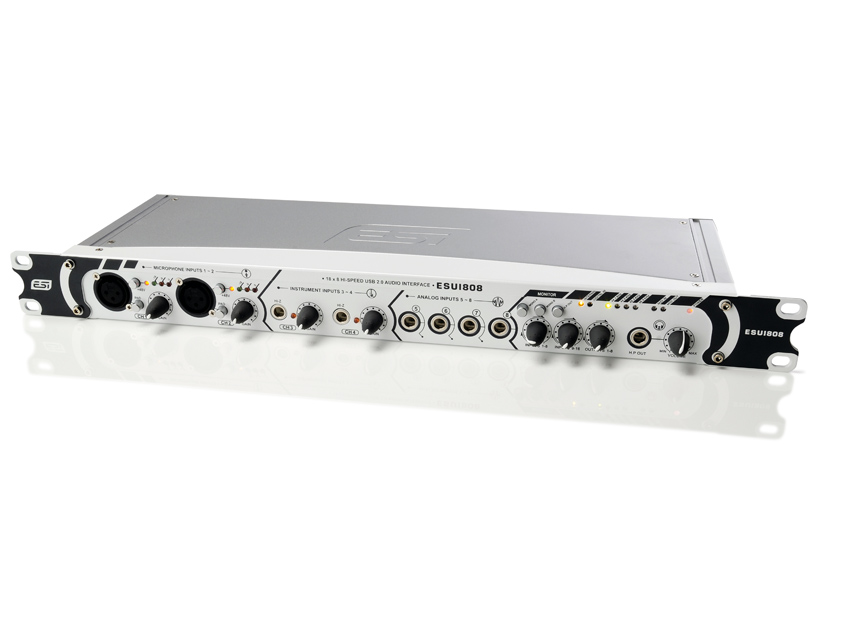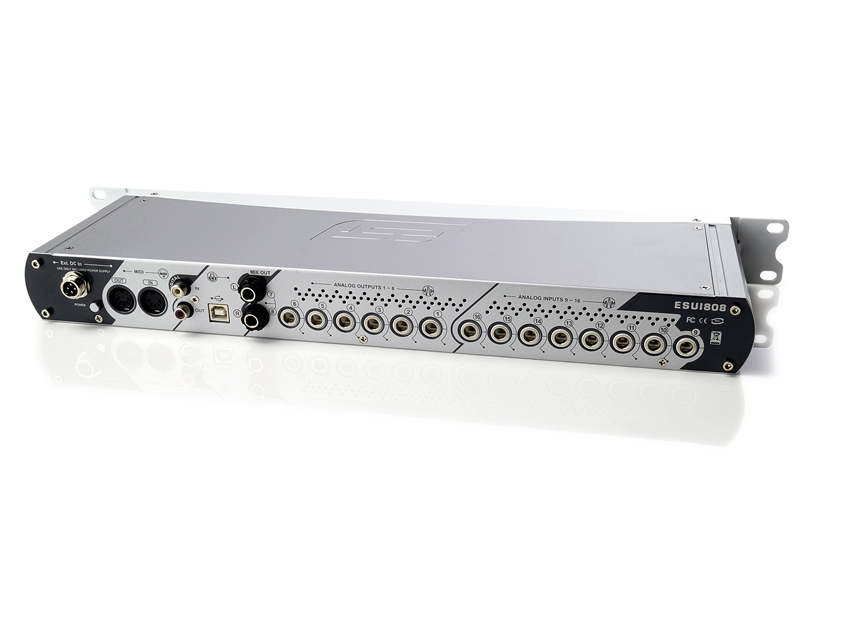MusicRadar Verdict
The ESU1808 is a fine buy if you want a lot of audio ins and outs but don't have much cash.
Pros
- +
Plenty of audio I/O at a very affordable price. Individual phantom power and pads on the mic inputs. Plenty of good bundled software.
Cons
- -
Not much software for Mac users.
MusicRadar's got your back

ESI ESU1808

ESI ESU1808
The ESU1808 is an audio/MIDI interface that hooks up via USB 2.0 and boasts a whopping 18 audio inputs, as well as eight audio outs.
MIDI I/O is also available from this rackmountable device, along with S/PDIF via phono for digital audio connection. That's an awful lot of connectivity for one 1U box.
Before plugging in and making some noise, a trip to the manufacturer's website is necessary in order to download the latest Vista or OS X drivers. Mac owners running Leopard will also need to perform a firmware upgrade to get things going.
The on-screen control panel is tidy enough, with level meters for the 16 analogue ins and dual digital ins, plus meters and sliders for the eight outs. The latter can be linked into four pairs if need be and you have the choice of balanced and unbalanced lines.
Hardware overview
Neat design extends to the hardware unit itself. At the front and on the far left there are dual XLR audio ins with independent phantom power. Each input has its own pad button alongside comfortingly rubberised level knobs and LED level indicators.
Moving along, there are two Hi-Z (high impedance), 1/4-inch jack unbalanced ins for instrument connection, each with a rotary knob for controlling input level. Analogue inputs five to eight are designed for unbalanced signals via 1/4-inch jacks, their front-panel location making for convenient reconfiguring of line-ins should you decide to house the 1808 in a rack.
One feature you don't often see on a unit of this type is a Mono mix button, but the 1808 has two of them. A press of Mono A enables you to create a mono mix of signals arriving at inputs one and two, while Mono B does the same for inputs three and four. So, if you suffer from that annoying phenomenon of only being able to hear a signal on just the left or right stereo channel, pressing the buttons will centre the sound.
Above the dual input rotaries (channels 1-8 and 9-16) and the master level control for all eight outputs and the headphone section, there's a row of status LEDs. Sample rates range from 44.1kHz to a respectable 96kHz at 24-bit and the LEDs provide an at-a-glance view of which rate is selected. Also featured are digital in, clock and MIDI I/O indicators - all very convenient
What's decidedly inconvenient, though, is the location of the power switch. It's round the back and a faff to reach if the 1808 is flightcased. That said, the plug for the supplied PSU has a knurled, screw-on sleeve, so you won't have to worry about the power cable dropping out after a bout of brutish behaviour.
Also at rear are the remaining eight audio ins (all on balanced 1/4-inch connections), the eight 1/4-inch balanced/unbalanced line outs (numbers seven and eight are what you'd use for monitoring the overall mix), MIDI and S/PDIF I/Os as well as the USB socket. The 1808 is USB 2.0 only, so if you're still running a computer with USB 1.1 ports, it's time for an upgrade.
Sound and software
In operation, the ESU1808 sounds as an audio interface should: neutral. While guitarists hanker for a signature tone from their audio devices, those making recordings usually want clean sound and that's what this device delivers.
ESI has gone to the trouble of bundling a good deal of sound-colouring software, though, as well as Steinberg's Cubase 4 LE sequencer (for Mac and PC) and a special edition of modular soft synth Tassman. So, you can add 'character' in software rather than it being introduced by the interface. It appears, however, that the bulk of the software bundle is Windows-only, so Mac users might be a little miffed.
Summary
What really impresses is the 1808's flexibility and, considering the price, build quality. It's unusual to see so many audio ins and outs on a sub-£350 interface - you could record a pretty populous band with just the one unit.
The casing seems road-worthy enough, so for live use, or for those who have numerous hardware synths, it's an ideal, cost-effective computer audio solution. It would be nice to see a FireWire port at rear, rather than USB, and a power switch at front, but these are minor niggles when you take into account how much is on offer to you for so little cash.
“A synthesizer that is both easy to use and fun to play whilst maintaining a decent degree of programming depth and flexibility”: PWM Mantis review
“I feel like that song had everything we needed to come back with”: Bring Me The Horizon’s Lee Malia on Shadow Moses, its riff and the secrets behind its tone, and why it was the right anthem at the right time
“I said, ‘Are we sure we can write a song about death?’”: The story of Mike + The Mechanics' classic No.1 The Living Years









